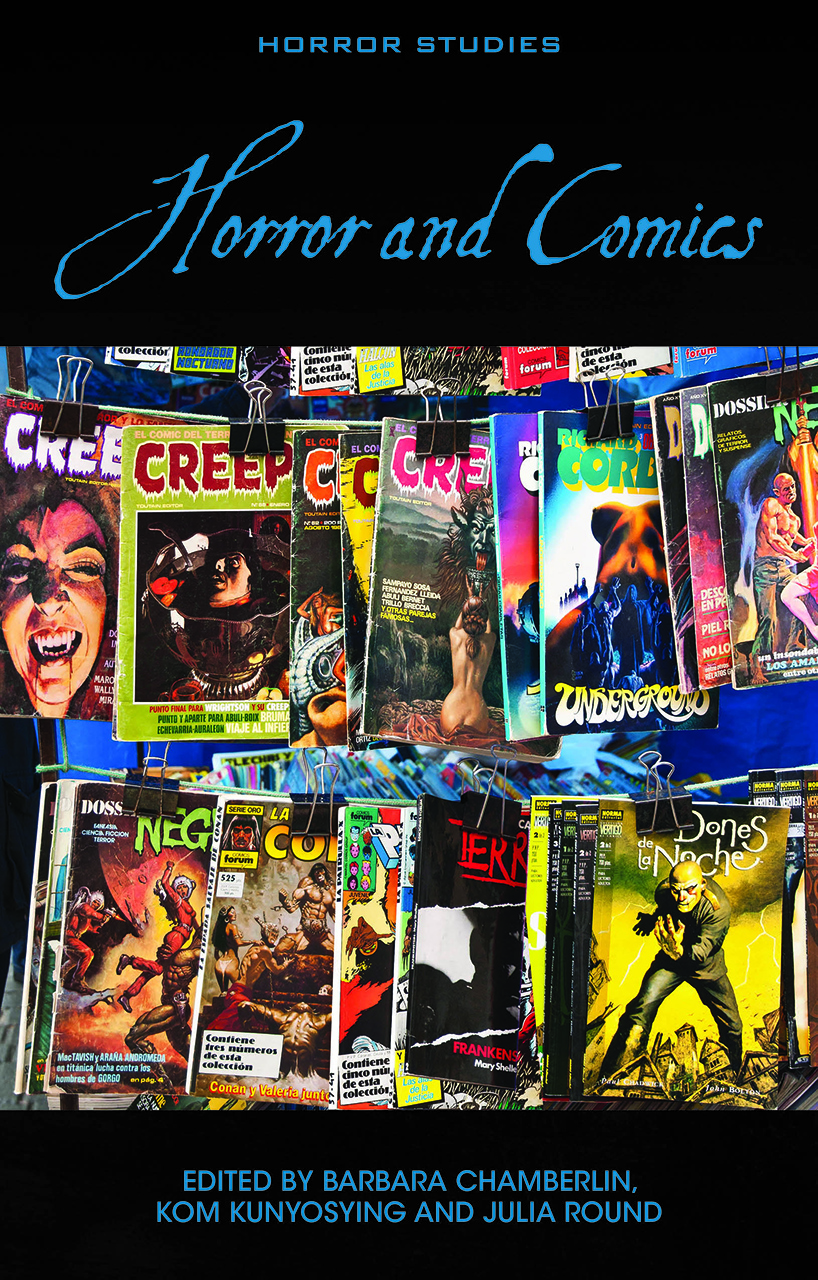
reviewed by Elizabeth Brown, Assistant Teaching Professor, and Cody Parish, Program Director, University of Colorado Colorado Springs
Barbara Chamberlin, Kom Kunyosying, and Julia Round, eds. 2025. Horror and Comics. Cardiff: University of Wales Press, 2025. 296 pp. US $75.00 (Hardcover). ISBN: 978-1-8377-2255-6. https://www.uwp.co.uk/book/horror-and-comics-round-et-al/
Far more complex than its title suggests, Horror and Comics delivers an array of original essays on the global genre of horror comics. This collection, as the editors make clear in their introduction, seeks to move existing scholarly conversations beyond specific comic publishers, individual creators, finite historical periods, and bias toward popular Western comics. Instead, it includes essays organized into three parts, each composed of four chapters, that carve out space to introduce new questions around the themes and rhetoric of the medium, yet refrain from creating an exhaustive anthology of all global horror comics.
Part one presents essays that examine the fluidity of horror comics and the ways in which they both draw from, and influence comics of other genres. Distinguished by its visual essay format, Elizabeth Allyn Woock’s opening chapter analyzes the thematic evolutions found in comic adaptations of Edgar Allan Poe’s “The Black Cat.” Woock’s essay privileges readers’ multimodal knowledge of comic convention to depict its argument in an exciting example of form following function--a scholarly comic about comics! It is worth noting, however, that the use of Chiller font for the lettering makes the text inaccessible. The second section of the collection consists of essays that examine representations of Othered identities in horror comics--including women, queer folks, and black, Latinx, and rural communities--for the ways in which they are rendered monstrous and for how these marginalized characters, at times, regain agency through their monstrosity. Of note is Keiko Miyajima’s chapter on Ito Junji’s Tomie. Miyajima interrogates the ways in which Ito utilizes “aspect-to-aspect” visual presentation to position the female gaze as a disruptive force to the male gaze and reframe the abject monstrous-feminine of the Japanese bishōjo as desirable. The final part of Horror and Comics features cultural-historical readings of horror texts depicting national anxieties, with Christy Tidwell’s chapter providing a rich, nuanced critique of Slow Death Funnies, that, at once, praises the comic as a subversive example of 1970s’ American ecohorror, while simultaneously critiquing it for its “sexism, ableism and ecofascism” (p. 297).
Horror and Comics boasts rich analyses brimming with historical depth on comics from Italy, Brazil, Germany, Japan, and the United States, including comics published between the 1600s and 2021. Beyond traditional horror comics and graphic novels, the contributors consider Italian fumetti neri, or black comics; Japanese manga; documentary/nonfiction comics; and underground comix. However, the texts examined only partially meet the editors’ goal of expanding existing discussions of horror comics to a global stage: just five of the twelve chapters focus on non-English language comics, whereas analyses of more comics from the global south would enhance the volume. Materially, the use of visuals is inconsistent throughout the volume, with some chapters featuring copious reproductions and others none at all--possibly pointing to the complexities of licensing rights in a project with as ambitious a scope as this one. Moreover, the comics reproductions themselves appear inconsistent, as pages of Tomie in the original Japanese used in Miyajima’s chapter, for example, show up in poor resolution should the reader magnify the screen to try to read them. Triebel and Vanderbeke reference and reproduce 16th-Century German woodcuts, but their horizontal orientation clashes with the page format of the volume. There is also inconsistency in the editing and individual organization of the essays. The texts lack abstracts and writers’ theses occasionally lacked development or were buried within their writing, making this text less accessible to new scholars. With its varied themes and approaches to scholarship, Horror and Comics is, first and foremost, for rhetorical scholars of horror as a genre, with secondary overlap into the study of comics as a medium.
Table of Contents
Introduction – Barbara Chamberlin, Kom Kunyosying, and Julia Round
PART ONE: Crossing Genres, Blurring Boundaries
Multimodal Mirroring in ‘The Black Cat’ – Elizabeth Allyn Woock
Satanic Feminism and Decadent Aesthetics in Guido Crepax’s ‘Valentina’ Comics – Miranda Corcoran
The Living, the Dead and the Living Dead: Brazilian Horror Imagery and
Genre Hybridisation in Shiko‘s Três Buracos – Tiago José Lemos I
Monteiro and Heitor Da Luz Silva
Befriending the Past: The Genre-Bending Vanessa Comics Series (1982–1990) and its Historical Context – Barbara M. Eggert
PART TWO: Identity, Agency, Humanity
‘I’m not who he thinks I am’: Identity and Victimhood in Country Horror Comics – Matthew Costello
‘What’s one more monster?’: Articulations of Latinx Monstrosity and Whiteness in Border Town – Anna Marta Marini
‘Still pretty, ain’t she?’: The Female Gaze and the Queer Monstrous Feminine in Itō Junji’s Tomie – Keiko Miyajima
Sinister Houses and Forbidden Loves: Queer Identity in DC’s Gothic Romances – Lillian Hochwender
PART THREE: Society, Anxiety, Politics
Abjection, Ambivalence and the Abyss in EC’s New Trend Line – Alex Link
The Power of a Demon and the Heart of a Human: The Darkness of Humanity in Devilman – Meriel Dhanowa
Comics and the Horrors of Reality – Dirk Vanderbeke and Doreen Triebel
‘REALITY scarier than any boogeyman’: Shock, Exploitation, and Environmentalism in Slow Death Funnies – Christy Tidwell
Afterwords – Barbara Chamberlin, Kom Kunyosying, and Julia Round




